Checking on Wilde: Deep Hive Body
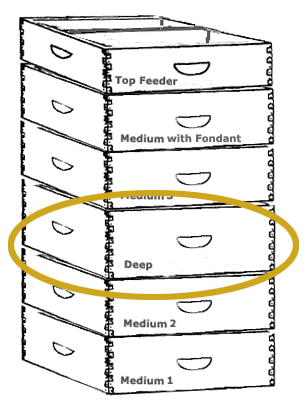 |
This is an overview of my "Wilde" colony, a hive of bees named after Oscar Wilde. The queen bee of this colony is named Elizabeth. These honeybees are New World Carniolans, a breed active at lower temperatures and known for beginning to raise brood early in the year. This page contains pictures taken during inspection of the biggest box of the colony: a deep hive body used, for no particular reason, as a honey super immediately above the shrimpy brood area. The deep is circled in gold at left. Other boxes to visit: |
Deep Hive Body Honey Super
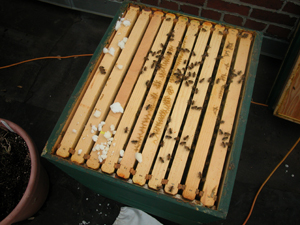
This deep hive body was placed out of hope that the Carniolans would expand their brood nest beyond the mere two medium boxes they had managed to draw out and fill with new bees, but it became a honey super anyway — a really dumb, ultra-heavy honey super.
The white sugary lumps have fallen through the upper boxes from a grease patty that the Carnies of the Wilde colony refused to touch, even though it was rumored to have health promoting qualities. This is another way in which the honeybees are like children to me.
The light brown tracings you can see on the middle two frames are beeswax, something the Carnies have been a bit lazy about making or using in my experience. Between the slats on the center right, I can see an enormous number of bees! The cluster that I thought would be contained by the medium super I just looked at was apparently just the beginning. Mite infestation or not, this colony may have a serious population after all!
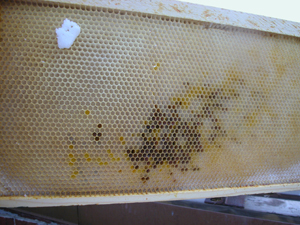
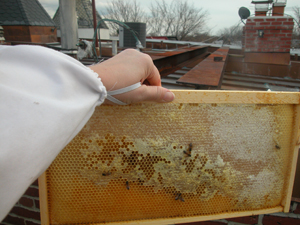
The outside of the leftmost frame has been emptied, just like the box above. The bees have started to stow stuff in there, though. It looks like pollen, a little bit of sugar syrup, and maybe propolis. The dark stuff is a little scary, since foul brood can look like that. But the material does not stink (the disease would) and there was never any larvae in here (where the disease grows), so it must be propolis. Let's make a personal note to research this.
The other side of the frame contains quite a lot of honey that is being eaten by bees. This is quite fine.
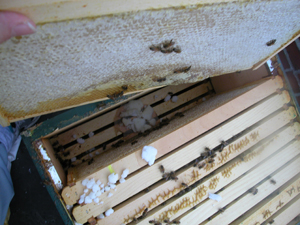
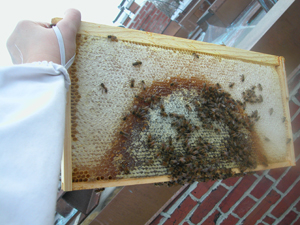
When I pulled the second frame in, I caught sight of a grease patty I placed a real long time ago, maybe October. Geez, they hate the things, don't even want to be bothered getting them out of the way. This frame is FULL of honey, though. Seems maybe these bees don't need more syrup. but I should make sure they can get to their stores. Kinda looks like the top of a brood nest on the bottom, though...
Then the next frame, and HOLY CATS! the brood area DID once reach into this deep box, to exactly the right height for a normal brood area! You go, Carnies! Yay, Queen Elizabeth.
But wait: the workers have filled in the former brood area with honey. They are literally squirrelling the stuff away in space that Queen Elizabeth is going to need soon. Hmmm. There does not seem to be a food emergency: is there a SPACE emergency?
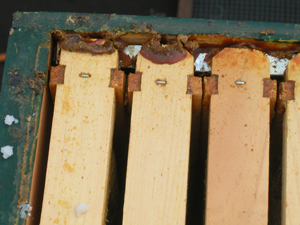
Once again, I seemed to be bumping up against the edge of the cluster ("Oh my goodness, so many bees!") so I decided to move on to the next box, with some trepidation.
After sliding the frames back in, it occurred to me how much propolis these girls produced, compared to the relatively small amount of beeswax they seem to crank out. Here's a close up of what I have to pry through to get the frames out.
On a cold day, propolis is actually hard and brittle. Today, at 61 degrees F, it was like really stiff carmel. My goal was to somehow pry steadily and firmly without ripping the frames apart or cutting abruptly down when a joint let loose. The latter annoys bees to no end, and I was working without gloves (but with smoke) at the moment.
<< Home